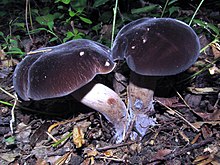| Tylopilus alboater | |
|---|---|

| |
| Scientific classification | |
| Domain: | Eukaryota |
| Kingdom: | Fungi |
| Division: | Basidiomycota |
| Class: | Agaricomycetes |
| Order: | Boletales |
| Family: | Boletaceae |
| Genus: | Tylopilus |
| Species: | T. alboater
|
| Binomial name | |
| Tylopilus alboater | |
| Synonyms[1][2] | |
|
Boletus alboater Schwein. (1822) | |
| Tylopilus alboater | |
|---|---|
| Pores on hymenium | |
| Cap is convex or flat | |
| Hymenium is adnate | |
| Stipe is bare | |
| Spore print is pink | |
| Ecology is mycorrhizal | |
| Edibility is edible | |
Tylopilus alboater, called the black velvet bolete, by some, is a bolete fungus in the family Boletaceae. The species is found in North America east of the Rocky Mountains, and in eastern Asia, including China, Japan, Taiwan, and Thailand. A mycorrhizal species, it grows solitarily, scattered, or in groups on the ground usually under deciduous trees, particularly oak, although it has been recorded from deciduous, coniferous, and mixed forests.
The fruit bodies have a black to grayish-brown cap that measures up to 15 cm (5.9 in) in diameter. The caps of young specimens have a velvety texture and are covered with a whitish to gray powdery coating; this texture and coating is gradually lost as the mushroom matures, and the cap often develops cracks. The pores on the underside of the cap are small and pinkish. The stem is bluish purple to black, and measures up to 10 cm (3.9 in) long by 4 cm (1.6 in) thick. Both the pore surface and the whitish cap flesh will stain pink to reddish gray, and eventually turn black after being cut or injured. The mushroom is edible, and generally considered one of the best edible Tylopilus species.